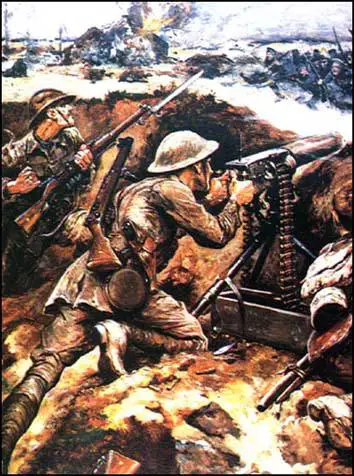Vickers Gun
In 1912 the British Army adopted the Vickers as its standard machine gun. Produced by the Vickers Company, it was a modified version of the Maxim Machine-Gun. The Vickers Gun used a 250 round fabric-belt magazine and had the reputation as a highly reliable weapon.
The .303 Vickers Gun could fire over 600 rounds per minute and had a range of 4,500 yards. Being water-cooled, it could fire continuously for long periods. There were usually six men in a Vickers gun team. In his book, With a Machine Gun to Cambrai, George Coppard, explained how the Vickers Gun Team worked. "Number One was leader and fired the gun, while Number Two controlled the entry of ammo belts into the feed-block. Number Three maintained a supply of ammo to Number Two, and Number Four to Six were reserves and carriers, but all the members of the team were fully trained in handling the gun."
When war was declared in August, 1914, Vickers were manufacturing 12 machine guns a week. Demand from the British Army was so high that Vickers had to find new ways of increasing production. By 1915 Vickers supplied the British armed forces with 2,405 guns. These increases continued throughout the First World War: 7,429 (1916); 21,782 (1917) and 39,473 (1918). The Vickers Company was accused of profiteering when in the early stages of the war they charged the Home Office £175 per gun. Under pressure from the government, Vickers reduced the price to £80 per gun.
Fitted with interrupter gear, the Vickers was also standard armament on all British and French aircraft after 1916.

winning the Victoria Cross in 1916 by using
a Vickers Gun to stop a German advance.
Primary Sources
(1) George Coppard, With A Machine Gun to Cambrai (1969)
The Vickers .303 water-cooled gun was a wonderful weapon, and its successful use led to the eventual formation of the Machine-Gun Corps, a formidable and highly-trained body of nearly 160,000 officers and men. Devotion to the gun became the most important thing in my life for the rest of my army career.
The Vickers gun proved to be most successful, being highly efficient, reliable, compact and reasonably light. The tripod was the heaviest component, weighing about 50 pounds; the gun itself weighed 28 pounds without water. In good tune the rate of fire was well over 600 rounds per minute, and with the gun was firmly fixed on the tripod there was little or no movement to upset its accuracy. Being water-cooled, it could fire continuously for long periods. Heat engendered by the rapid fire soon boiled the water and caused a powerful emission of steam, which was condensed by passing it through a pliable tube into a canvas bucket of water. By this means the gun could continue to fire without a cloud of steam giving its position away to the enemy.
There were normally six men in a gun team. Number One was leader and fired the gun, while Number Two controlled the entry of ammo belts into the feed-block. Number Three maintained a supply of ammo to Number Two, and Number Four to Six were reserves and carriers, but all the members of the team were fully trained in handling the gun. In the trenches the Vickers were primarily used for defence, but it was also effectively used to assist an attack, by indirect or barrage fire, and to restrict and harass enemy movement behind their lines.
When in reserve, it was normal routine in the machine gun section to give guns, accessories and equipment a complete overhaul. Most of us were dedicated enthusiasts, and strove to maintain the weapons at peak efficiency. Gun barrels had an average life of 18,000 rounds of firing, after which accuracy fell off. A spare barrel was carried for replacement when necessary.
